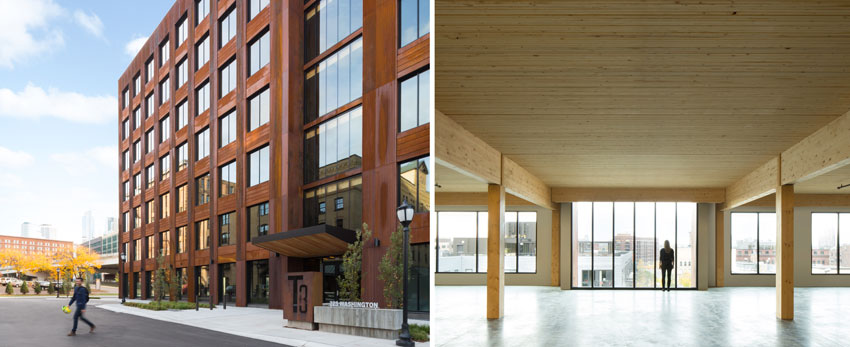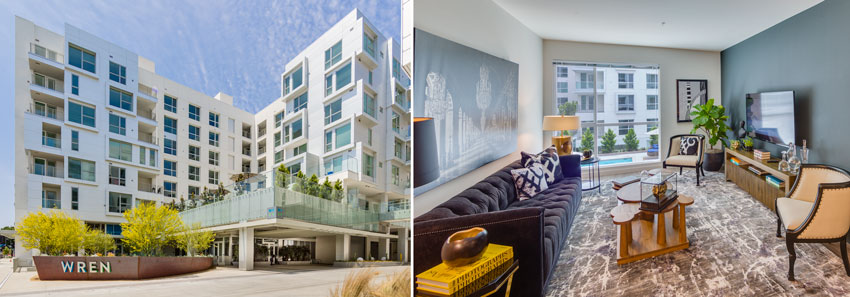Structural Wood Building Systems
Choosing the right material for a sustainable, safe, and resilient project
![]() Continuing Education
Continuing Education
Use the following learning objectives to focus your study while reading this month’s Continuing Education article.
Learning Objectives - After reading this article, you will be able to:
- Compare the key differences between light-frame and mass-timber structural systems, and explain how each can contribute to sustainable and resilient design.
- Describe the applications for both light-frame and mass-timber structural systems and the classes of buildings where they are appropriate.
- Identify performance benefits for each system, including fire safety, seismic stability, and wind resistance, as well as pertinent codes related to each.
- Examine several case studies that feature light-frame and mass-timber projects, all of which incorporate environmentally sensitive design.
Introduction to Light-Frame Structural Systems
Whether designing for light-frame or mass-timber structural systems, project teams that opt for wood can benefit from the material’s versatility, sustainable supply chain, and benefits to occupants, as well as thermal, acoustic, seismic, and fire performance. Wood can also help to maximize value through gains made in square footage and building height.

Photo courtesy of CBPhotography & Designs
Orchards at Orenco | Ankrom Moisan Architects
Light-frame wood construction has long been the go-to framing choice for low-rise and, increasingly, midrise residential and commercial buildings. Cost-effectiveness, material-use efficiency, ease of assembly, minimal environmental impact, and the ready availability of labor and materials make light-frame construction the most common type of wood construction in North America. Typically, nail-assembled light-frame construction uses a formulaic combination of dimensional lumber, I-joists, trusses, structural composite lumber, and plywood and oriented strand board (OSB) decking and sheathing for floors, walls, and roof decks.
While mass-timber structures are often built as components off-site and assembled at the project site, light-frame construction typically occurs entirely on-site. Increasingly, however, elements of light-frame buildings are fabricated off-site and assembled on the job. Off-site construction offers greater control over construction conditions and improved safety oversight for all material types, while requiring less skilled labor on-site and contributing to faster construction timelines.
Light-Frame Roofs and Floors
Typical light-frame roof and floor systems consist of repetitive framing members, such as rafters or trusses with wood structural panel decking. Framing components include solid sawn dimension lumber, I-joists, structural composite lumber, and parallel chord and pitched trusses. OSB and plywood are used interchangeably as decking material.
As part of the lateral resisting system, roofs and floors are designed as horizontal diaphragms and may require special considerations for high loads or irregularly shaped structures. Diaphragm design can also affect the structure’s load distribution, so in making an assumption as to whether a diaphragm is flexible or rigid, it is important to analyze the lateral deflections.
Roofs shed water and act as part of the thermal building envelope. In many nonresidential applications, low-slope roofs are common and may need special attention to ensure building longevity. How the roof is insulated can often affect the building’s thermal performance. Prescriptive paths within the energy codes prefer continuous insulation, but performance paths offer opportunities for other insulation techniques.
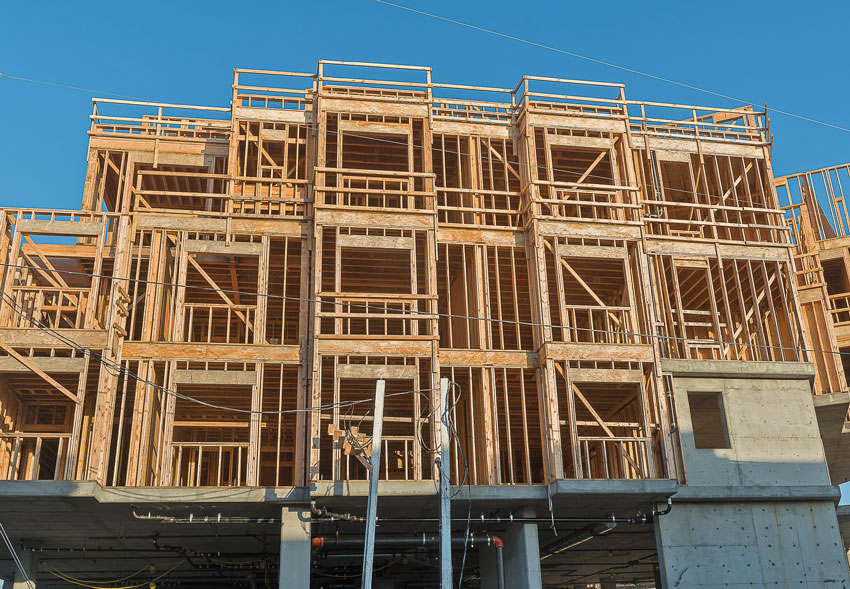
Photo courtesy of Think Wood
Typical light-frame roof and floor systems consist of repetitive framing members such as rafters or trusses with wood structural panel decking.
Light-Frame Walls
Typical light-frame walls consist of studs spaced at 12 to 24 inches on center (o.c.) with a double top plate and single bottom plate, and they are often sheathed with wood structural panels. Construction depends on the amount of load bearing on the wall, its height, and whether it is part of the lateral force-resisting system.
Walls higher than 12 feet are often designed as tall walls and may require additional engineering.
Shear walls refer to wall components that participate in the lateral resistance of the structure and can be designed a number of ways; methods include segmented, perforated, and force transfer around openings.
Approaches to Light-Frame Construction
There are several approaches to light-frame wood construction, and each is suited for a specific application, most often in the Type III (four to five stories) and Type V (two to three stories) categories. These approaches are distinguished by the wall-to-floor connection and include platform, balloon, semi-balloon, plank and beam, and truss framed.
Platform
In platform construction, the floors are framed separately, and the walls of the story beneath each new level bear the load. The rim board, which is typically made of structural composite lumber, transfers lateral and vertical loads. Framing members are typically spaced between 12 and 24 inches o.c. Due to its relative ease of building, platform framing is the most common form of light-frame construction for Type VA residential buildings.
Balloon
In balloon framing, vertical structural members extend from the foundation to the rafters, and framing members are spaced between 12 and 24 inches o.c. The wall extends two or more stories, and the floor is hung off a ledger connected to the wall. Balloon framing is often used in industrial and retail applications where a parapet is needed.
Semi-Balloon
Often used for multistory projects due to its fire-management abilities, semi-balloon framing sees floors suspended from the double top plates of the walls below them, with the walls stacked directly on the wall below. This approach limits shrinkage throughout the building, although it requires more hardware than other framing types. Framing members are typically spaced between 12 and 24 inches o.c. Semi-balloon framing is an alternative to platform framing for Type VA and Type IIIA buildings.
Plank and Beam
Historically used in heavy-timber buildings, plank-and-beam construction has since been adapted for light-frame projects. It uses larger wood members and spaces them more widely than does platform or balloon construction. This type of framing sees 2-inch subfloors or roofs on post-or pier-supported beams spaced up to 8 feet. Additional framing allows for interior and exterior cladding and finishes.
Truss Framed
Truss-framed light-frame construction employs engineered wood systems made up of roof and floor trusses as well as wall studs for additional strength. These assemblies are fabricated off-site, offering the additional advantages previously discussed. Truss-framed systems also boast greater resilience, making them particularly well-suited for areas that experience high winds. Spacing of 24 inches between frames is possible. A lack of headers, floor beams, and interior columns contributes to material and cost savings, maximizing value with gains in square footage and height.
Description of a Mass-Timber System
Mass timber is a category of framing styles typically characterized by the use of large solid-wood panels for wall, floor, and roof construction. Building with mass timber offers a reduced carbon footprint, construction efficiency, fire and life safety, and occupant well-being. We will discuss these performance benefits in more detail later in the course, but let’s first review the primary types of mass-timber construction.
Glulam
Glue-laminated timber (glulam) is a structural engineered wood element commonly used for beams and columns in residential and commercial applications. To form a glulam component, dimension lumber wood laminations are positioned according to their stress-rated performance characteristics. In most cases, the strongest laminations sandwich the beam in order to absorb stress proportionally and ensure the member’s longevity. The laminations are jointed end to end, allowing for long spans, and are bonded with a durable, moisture-resistant adhesive. The laminations’ grains run parallel with the member’s length to improve its strength.
Glulam is stronger than steel at comparable weights, and it is stronger and stiffer than dimension lumber, according to APA – The Engineered Wood Association. That makes the material a cost-effective choice for long, structural spans and tall columns with minimal need for additional support. Glulam is a highly visible form of mass timber in contemporary projects, with long spans framing signature designs that have been left exposed to take advantage of wood’s natural aesthetic. Glulam can be used in interior and exterior applications, as several manufacturers sell glulam products with adhesives that can withstand moisture and wear from use outdoors.
NLT
Nail-laminated timber (NLT or nail-lam) is a century-old construction method that is undergoing a design renaissance. It can be found today in many historical buildings as well as compelling new projects of all sizes, where its structural performance and design elegance come together to create inspiring spaces.
NLT gets its strength and durability from the nails that fasten individual dimension lumber, stacked on edge into a single structural element. Applications for NLT include flooring, decking, roofing, and walls as well as elevator and stair shafts. Because NLT is made of wood, it offers a consistent and attractive appearance for decorative or exposed-to-view applications.

Photo courtesy of Think Wood
NLT gets its strength and durability from the nails that fasten individual dimension lumber, stacked on edge, into a single structural element.
CLT
Cross-laminated timber (CLT) is a relatively new structural engineered wood-panel system that is gaining popularity in the United States after being widely adopted in Europe. CLT panels are made of layers of lumber boards (usually three, five, or seven) stacked crosswise at 90-degree angles and glued into place. The panels can be manufactured at custom dimensions, though transportation restrictions dictate their length.
Applications for CLT include floors, walls, and roofing. The panels’ ability to resist high racking and compressive forces makes them especially cost-effective for multistory and long-span diaphragm applications. CLT is the basis of the tall wood movement, as the material’s high strength, dimensional stability, and rigidity allow it to be used in mid- and high-rise construction.
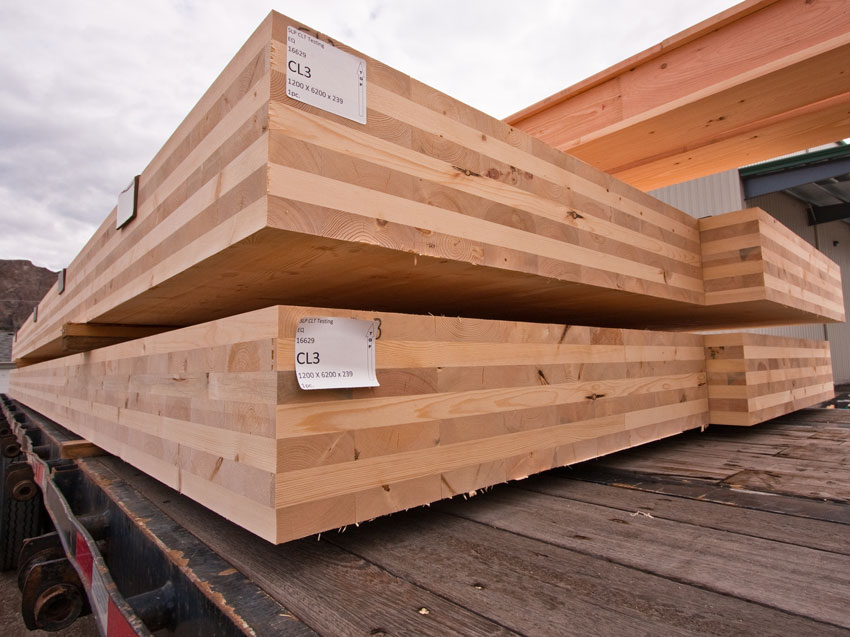
Photo courtesy of Structurlam
CLT is the basis of the tall-wood movement, as the material’s high strength, dimensional stability, and rigidity allow it to be used in mid- and high-rise construction.
DLT
Dowel-laminated timber (DLT) is common in Europe and is gaining traction in the United States for its ease of use with computer-controlled (CNC) machinery, such as lathes, routers, and mills, and its all-wood composition. DLT is similar to NLT, but instead of nails or screws, DLT uses wood dowels to join laminations. To form DLT members, softwood lumber panels are stacked like NLT and are friction fit together with hardwood dowels. Friction fit, achieved by the differing moisture content of the softwood panels and the hardwood dowels, affords additional dimensional stability. The dowels can be inserted diagonally, offering additional resistance. Because DLT does not use nails or screws, it is easier and safer to mill and route, and the lack of an adhesive is also attractive for projects looking to maximize the use of wood.
In application, DLT performs similarly to glulam and NLT. Because its grains run in one direction, DLT is a next-generation mass-timber product that allows for significant architectural flexibility and is well-suited for horizontal spans, such as flooring and roofing applications.
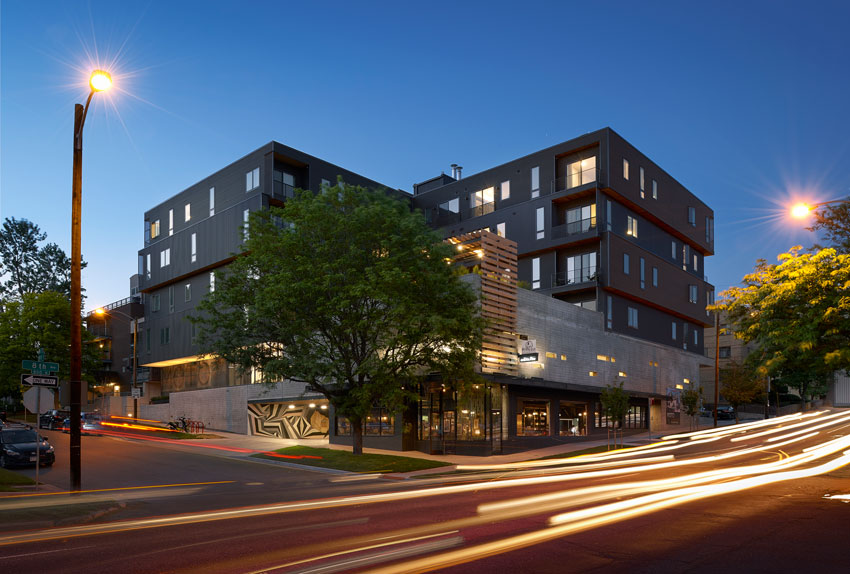
Photo courtesy of Ryan Gobuty
MOTO | Gensler
Buildings with wood podiums have a lower mass, meaning less material is needed for the foundation and shear walls. Consistent structural material use throughout the building also reduces the need for different trades on-site, streamlining labor costs and construction timelines.
Light-Frame Applications
Wood is increasingly being used in midrise buildings due to its durability and low cost relative to other material options. In fact, the International Building Code (IBC) permits up to six stories of wood-framed construction depending on building type (five for affordable, military, multifamily, senior, and student housing, and six for certain types of commercial structures). Additionally, the use of concrete-and-steel podiums allows light-frame construction to be used to create even taller buildings, with the podium and wood structures treated separately and divided by a horizontal fire-rated assembly.
Updates in the 2015 IBC allow for multistory podiums, which makes it easier for architects to use wood to effectively and economically capitalize on the growing demand for high-density, mixed-use structures featuring office or multifamily residential space atop ground-level retail and dining. Grocery-anchored residential developments are particularly popular today and can benefit from the ability to erect multiple stories of wood-framed construction atop a one- or two-story concrete or masonry podium. Note that previous versions of the IBC require exemptions from local authorities in order to build more than a single-level podium, and those may still be required in jurisdictions following earlier versions of the code.
Project teams seeking a more environmentally friendly structure are designing their podiums out of wood too. Buildings with wood podiums have a lower mass, meaning less material is needed for the foundation and shear walls. Consistent structural material use throughout the building also reduces the need for different trades on-site, streamlining labor costs and construction timelines.
Light-frame systems are typical in Type V and Type III construction and are described in IBC sections 602.3 and 602.5 respectively. Chapter 23 of the 2012 IBC covers general guidelines for structural wood products and the associated minimum design requirements. This chapter offers an overview of wood design and references these American Wood Council publications:
- The National Design Specification® (NDS®) for Wood Construction includes design equations and properties for most wood products, systems, and connections. It is supplemented by design examples and commentary.
- Special Design Provisions for Wind and Seismic contains information on lateral-force-resisting system design, including design methods, equations, and system capacities.
- The 2012 Wood-Frame Construction Manual (WFCM) for One- and Two-Family Dwellings includes tabulated engineered and prescriptive design and construction provisions for connections, wall systems, floor systems, and roof systems based on the specific loads from ASCE 7-10: Minimum Design Loads for Buildings and Other Structures.

Photo courtesy of Ema Peter
T3 | Michael Green Architects + DLR Group
For office, mixed-use, multifamily, or hospitality environments, the aesthetic of mass timber can be a particular draw, resulting in higher rents and longer-term tenants.
Mass-Timber Applications
Because of its strength and dimensional stability, mass timber offers a low-carbon alternative to steel, concrete, and masonry for many applications and is typically used in Type IV construction. A complement to other wood-framing systems, it can be used on its own, in conjunction with other wood systems such as post and beam, or in hybrid structures with steel or concrete. Mass timber is not necessarily a good substitute for light-wood-frame construction only because dimension lumber framing offers such a compelling combination of performance and cost where permitted by code. For this reason, building types where designers typically default to forms of construction other than light-frame—including offices, schools, public and institutional buildings, and taller mixed-use occupancies—may offer greater appeal for mass timber than low-rise commercial or residential buildings, although examples of the latter do exist.
For office, mixed-use, multifamily, or hospitality environments, the aesthetic of mass-timber can be a particular draw, resulting in higher rents and longer-term tenants. Mass timber has a number of characteristics that make it attractive for schools and universities as well. These include, for example, the ability to construct an entire project over the summer while students are off campus, the potential efficiencies of replicable modular designs, a lighter carbon footprint, and the positive impacts of exposed wood on student well-being. As the construction industry, accustomed to building institutional buildings such as schools using conventional wall, roof, and floor assemblies, gains more experience with these versatile new timber products, greater production economies will accrue, and more of timber’s potential benefits such as light weight, high strength, and workability will be captured.
Reasons to use mass timber in public and institutional buildings are similar to those for offices and schools, including a smaller carbon footprint and wood’s biophilic effects. The aesthetic possibilities are also exciting to many designers. With a growing body of research supporting the positive impacts of wood on occupant well-being, there is also a trend toward the use of mass timber in healing environments.
Taller Mixed-Use Occupancies
While most of this course focuses on structures that can be built under current U.S. building codes, a discussion of mass-timber is incomplete without reference to wood high-rises. Many examples exist worldwide, illustrating the potential of mass timber to bring environmental and other advantages to higher-density projects. In the United States, a number of tall-wood buildings are in design, including the winners of the U.S. Tall Wood Building Prize Competition. A tall wood building is a minimum of 80 feet in height.

Taller wood projects are a reality, with more developers and architects opting for mass timber as a sustainable solution to attain safe, cost-effective, high-performing buildings in urban-dense settings.
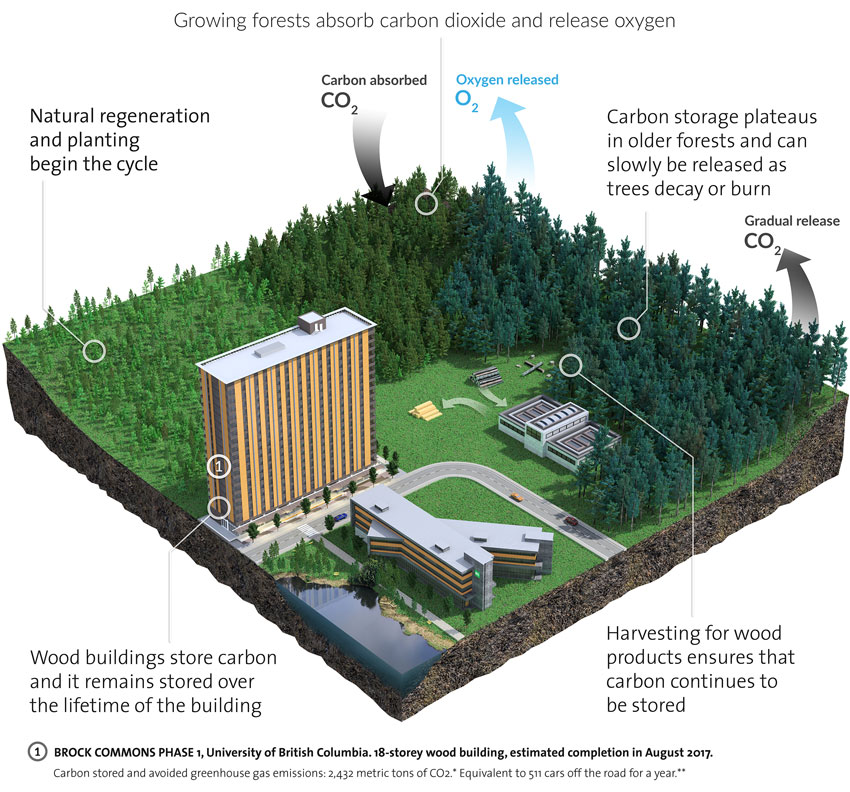
Wood structural systems are fully capable of meeting a nonresidential building’s longevity expectations. Wood should be considered a preferred material because it enables easy building modification in response to changing needs and materials are easy to recover when a building is decommissioned.
Established by the U.S. Department of Agriculture (USDA), Softwood Lumber Board (SLB) and Binational Softwood Lumber Council (BSLC), the competition was the first step in a process to showcase the safe application, practicality, and sustainability of tall-wood structures using mass timber, composite wood technologies, and innovative building techniques. Given that wood buildings over six stories are not currently within the prescriptive height limits of the IBC, designers of taller projects must follow an alternative-means process in consultation with the authority having jurisdiction over appeal of the building project. However, the International Code Council (ICC) Board of Directors recently approved the formation of a Tall Wood Ad Hoc Committee. Comprising stakeholders, code officials, and other interested parties, the committee will study tall-wood construction, and its findings may contribute to code changes for the 2021 IBC.
Why Build with Wood?
Sustainability: Carbon Footprint, Long Life Cycle, and Resiliency
Wood building products allow the use of a renewable and sustainable resources as an alternative to more fossil-fuel-intensive materials, resulting in a reduced carbon footprint. Designers of tall-wood buildings have been especially focused on the reduced carbon footprint achieved by using wood, which aligns with the goals of Architecture 2030. Reducing carbon is also a priority for many public buildings and schools.
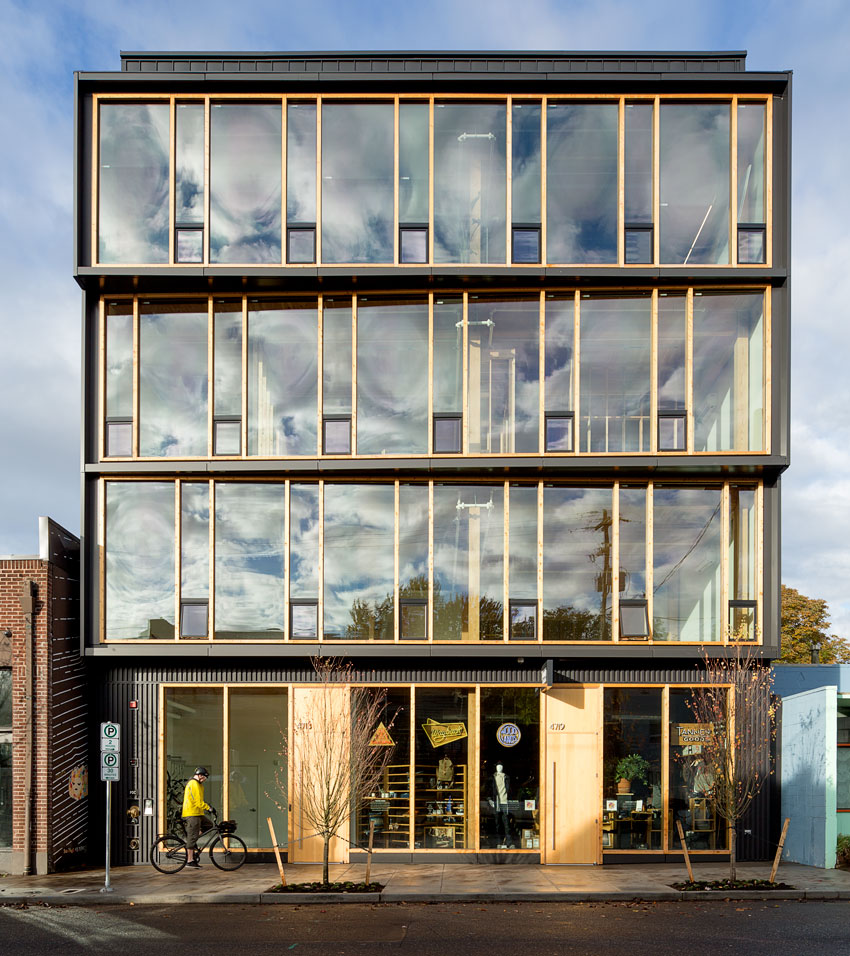
Photo courtesy of LEVER Architecture
Albina Yard | Lever Architecture
Left exposed, visible wood structural elements offer impressive visuals that accentuate a project’s design and improve occupant health and well-being.
In addition, wood buildings are very durable and resilient in cases of seismic or high-wind events. The world is full of examples of ancient wood-frame buildings that remain structurally sound. In fact, extended service life is one of the key advantages wood offers as a nonresidential building material. With proper design and construction, wood-frame buildings resist damage from moisture, insects, and other organisms and provide decades of service equivalent to other building types.
There are many applications where the natural durability properties of wood make it the material of choice. For example, wood is resistant to high relative humidity and many of the chemicals and conditions that adversely affect steel and concrete, such as corrosive salts, dilute acids, industrial stack gases, and sea air. Because of its resistance to these factors, building professionals often use wood for specific nonresidential structural applications, such as cooling towers and industrial buildings used for chemical storage.
Quality assurance and proper maintenance are key to ensuring that wood structures will provide the service life desired. There are recommended methods to protect wood-frame structures against durability hazards and thus provide maximum service life for the building. All require proper design and construction, including moisture control, termite and other pest control, durable materials, and quality assurance during design and construction as well as through a building’s service life using appropriate maintenance practices.
Wood structural systems are fully capable of meeting a nonresidential building’s longevity expectations. Wood should be considered a preferred material because it enables easy building modification in response to changing needs. Additionally, wood materials are easy to recover when a building is decommissioned.
Construction Efficiency
Wood can be a suitable replacement in applications that use concrete, masonry, and steel and is frequently quicker and easier to erect, especially in tight job sites. Light-frame and mass-timber construction are fast, and speed correlates to revenue, whether the project is an office, school, student residence, condominium, or hotel. Bernhard Gafner, formerly of structural engineering firm Fast + Epp, says, "A mass-timber project is approximately 25 percent faster to construct than a similar project in concrete." Noting the advantages for urban infill sites in particular, he says it also offers 90 percent less construction traffic (trucks delivering materials) and requires 75 percent fewer workers on the active deck, making for a much quieter job site.
The fact that wood weighs less than other materials also has a number of potential benefits, including smaller foundation requirements and lower forces for seismic resistance. Because mass timber is lighter than steel and concrete, it can be a good solution for sites where poor soil is an issue. There is also a trend toward the integration of services into prefabricated elements, such as panels and trusses.
Occupant Well-Being and Aesthetics
An increasing number of studies focused on wood’s biophilic aspects have linked the use of exposed wood in buildings with improved occupant health and well-being. Left exposed, visible wood structural elements offer impressive visuals that accentuate a project’s design. Modern wood products bring warmth and beauty to the interior while promoting a healthy environment.
Fire and Life Safety
Modern building codes take fire safety and protection seriously. All building materials experience negative impacts from exposure to fire: steel buckles, concrete spalls, and wood burns. Design and engineering analysis, along with supporting research, shows that structurally, wood meets and often surpasses prescriptive building-code requirements for fire, seismic performance, and wind resistance that allow its use in larger buildings. The main difference between the fire resistance of light-frame and mass-timber structural systems is that for mass timber, the fire resistance is inherent in the material (mass of product offers fire resistance), while light-frame systems require active fire-protection measures such as sprinklers, fire watch during construction, firewalls, etc.
North American fire-loss statistics reveal that death and injury in building fires are usually caused by smoke inhalation and occur long before structural failure. When exposed to fire, the outer layers of thick mass-timber members char to provide natural protection against fire penetration. The char layer insulates the wood, slowing combustion and delaying the rate at which heat moves into the layers of wood below. Those areas of the wood not exposed to heat or fire can retain full strength, allowing the member to continue to provide significant structural capacity for the building while it is evacuated. Mass timber’s density means there are no cracks for air or fire to enter, ensuring that the fire’s impact on the wood is gradual and predictable.
Light-frame structural systems, on the other hand, must employ fire-resistance-rated building assemblies to prevent, for a certain period of time, the spread of fire, smoke, and heat from one unit to another (essentially through walls and floors) and ensure that the structural integrity of the building is maintained. Fire resistance-rated walls and floors are also required for exit corridors and stairways to ensure that people can safely leave the building in the event of a fire.
Fire-resistance ratings provide a measure of the time that an assembly will withstand the passage of flame and smoke, and the transmission of heat when exposed to fire under specified fire conditions, including structural loads if applicable. Firewalls are fire separations of noncombustible construction. They have fire-resistance ratings as prescribed in building codes, and structural properties such that they will remain intact under fire conditions for the required fire-rated time. Firewalls are commonly used to divide row-housing blocks into smaller groups and resist the spread of fire from one group to another. They are also used to divide a large building into smaller units where standard fire-protection measures are applicable.
In addition, fire-safety measures must be taken during construction and in occupied buildings. Methods to mitigate the impact of fire on life, safety, and property include:
- Firewalls
- Gypsum encapsulation
- Automatic sprinklers
- Fire detectors and evacuation plans
- Fire-department consultation and approval
The IBC considers fire-impact management and fire-ignition prevention in its guidance on fire resistance. Wood products may be responsible for load-bearing functions, separating functions, or both. As a result, the IBC considers the following factors when determining fire resistance, or how long a component or assembly can continue its function(s) during a fire event:
- Structural resistance: The duration the assembly can support its load during a fire event.
- Integrity: Whether the assembly can prevent the spread of high-heat flames and gases.
- Insulation: Whether the assembly can prevent temperatures on surfaces not directly exposed to flames from rising above its pre-fire temperature by 325 degrees Fahrenheit (180 degrees Celsius) or 250 degrees Fahrenheit (140 degrees Celsius) on average.
Seismic Stability
Earthquakes are another critical concern for design professionals working in some of the most populated regions of the United States, particularly the West Coast. Because seismic events cannot be prevented, buildings in those regions must be designed to maintain structural integrity and keep occupants safe. Recent seismic events as well as research into material performance have given designers and engineers critical insight into how buildings perform under such stress, which is reflected in building codes and project applications.
Research and building-code development have proven that wood components, assemblies, and entire structures are capable of meeting or exceeding the most demanding earthquake and seismic design requirements. Products like CLT, NLT, DLT, glulam, and even light-frame structural systems give designers and engineers a readily available and robust selection of code-approved building materials that can help commercial and residential buildings and other infrastructure better withstand seismic events.
Wood-frame construction offers several characteristics to this end, including:
- Inherently flexibility: Wood’s ability to withstand high loads for short periods of time and retain its elasticity and ultimate strength is an asset in seismic zones.
- Light weight: Wood-frame buildings typically weigh less than those made of concrete and steel, reducing inertial seismic forces, which are proportional to weight, and therefore are more extreme for heavier structures.
- Ductile connections: The ability to yield and displace without fracturing under an earthquake’s abrupt lateral stresses is an attribute of wood-frame construction, which features several nailed connections that allow it to respond to seismic events without critical failure.
- Code compliance: Building codes prescribe minimum fastening requirements for connecting repeated wood-framing members, which is unique to wood-frame construction and benefits its seismic performance.
- Redundant load paths: The numerous fasteners and connectors used in wood-frame construction offer multiple, often redundant, load paths for seismic forces, reducing the chance the structure will collapse if some connections fail.
- Strength and stiffness: The thickness of mass-timber panels and the number and size of nails fastening the assemblies determine each component’s stiffness. Heavy bracing for shear walls can resist lateral distortion common in earthquakes.
The 2015 IBC and the American Society of Civil Engineers/Structural Engineering Institute Minimum Design Loads for Buildings and Other Structures (ASCE 7-10) represent codes and standards for seismic-resistive wood-frame buildings. These standards recognize how structures with ductile detailing, redundancy and regularity deliver high-performance seismic resistance.
Identifying the building risk category is critical to seismic-resistive design. The IBC and ASCE 7-10 group common building types into four levels of risk to human life during a seismic event, from least risk to most risk:
- Risk Category I: agricultural facilities and storage buildings
- Risk Category II: houses, apartment buildings, offices, and stores
- Risk Category III: schools and assembly buildings with occupancy of greater than 300
- Risk Category IV: critical services, including power-generating stations and police and fire stations
Each risk category corresponds to a seismic scale rating (from 1 to 1.5) and allowable drift by story height (from 2.5 percent to 1 percent). The requirements for seismic base shear and drift control in building design are scaled by risk category. The stringent requirements applied to Risk Category IV structures due to their essential nature intends to limit structural and nonstructural damage.
ASCE 7-10 groups wood-frame seismic-force-resisting systems (Table 12.2-1 in ASCE 7-10) accordingly: bearing walls, building frames, and cantilevered columns. Three seismic-force-resisting coefficients are used to gauge the performance of these systems, helping designers and engineers select the right one for their application:
- R factor: response modification coefficient (indicated by R)
- Cd: deflection amplification factor
- Ω0: overstrength factor
The National Design Specification (NDS) for Wood Construction is also helpful when designing wood-frame structures to withstand seismic events. The IBC-referenced design standard covers dimension lumber, glulam, structural composite lumber, and CLT as well as fasteners, connections, and fire design.
Wind Resistance
Seismic events tend to be regional, but buildings everywhere face the risk of damage due to high winds, with each structure reacting differently according to its stiffness, strength and shape. Therefore, all buildings must be designed to safely respond to lateral wind loads. Wood’s elasticity and strength give buildings an advantage during high-wind events.
There are many ways wood can be used to help buildings resist high winds, which can occur along the length and width of the building as well as through vertical uplift. In high-wind events, loads are typically applied in a series of short spurts. Wood is effective at resisting these loads because its elastic limit and ultimate strength are higher when tested for short periods of time.
Wood sheathing in the form of wood structural panels, fiberboard, particleboard, and board sheathing can be used as diaphragms and shear walls that transfer loads delivered by wind events to the building’s foundation. Rigid wood-frame construction, meanwhile, transfers lateral loads in the event of high winds. As with seismic performance, wood-frame construction’s numerous nailed connections give the load more paths to follow, reducing the chance of a structural collapse should some connections fail.
Wind-load requirements are covered under the national code standards but may vary by jurisdiction depending on wind zones. The IBC General Design Requirements for Lateral-Force Resisting Systems (Section 2305) advise on code requirements for wind and lateral-load resistance in buildings using wood shear walls and diaphragms:
- IBC Section 2308 offers guidance on wind and seismic loading for conventional light-frame construction.
- IBC Section 1609 must be considered for shear wall and diaphragm design when wind speeds exceed those allowed in IBC Section 2308. Section 1609 references wind loads established in ASCE 7-10.
- ANSI/AF&PA Special Design Provisions for Wind and Seismic Standard with Commentary (Wind and Seismic) is a referenced standard covering material selection, design, and construction of wood-frame assemblies. It largely follows the IBC, ASCE 7-10, and National Earthquakes Hazard Reduction Program.
Conclusion
We hope we have demonstrated the key differences between light-frame and mass-timber systems, including their applications, code considerations, and performance benefits. Wood structural systems will continue to play an increasingly large role in midrise building design due to its construction efficiency, sustainability, and resiliency over other building systems.
Design Guidance and Resources
There are many resources available to architects and engineers designing mass-timber projects.
- For general information, the Think Wood website offers an expanding library of materials on mass-timber products, research, building examples, and developments related to tall wood buildings.
- The National Design Specification® (NDS®) for Wood Construction is the IBC-referenced design standard for lumber, glulam, SCL, and CLT, including fire design, fasteners, and connections, etc. A mass-timber building in the United States cannot be designed without the NDS.
- The U.S. CLT Handbook includes detailed technical information on the use of CLT. It should be used in conjunction with information provided by manufacturers since most CLT currently available in North America is propriety (i.e., layups aren’t standard across suppliers).
- APA Product Reports signify a product’s compliance with relevant provisions of the model building codes. The L-Series covers products manufactured from lumber, veneer, or other wood base, such as glulam and structural composite lumber (SCL).
For one-on-one support (at no cost), technical experts at WoodWorks are available to provide free project assistance related to nonresidential and multifamily buildings in the United States, including those using mass timber. Designers have the option of contacting an expert in their region www.woodworks.org/projectassistance or emailing help@woodworks.org.


